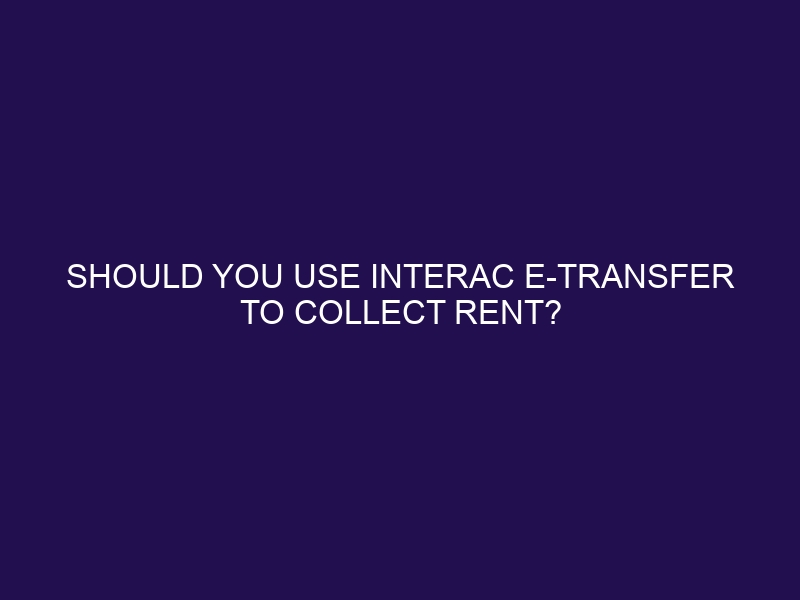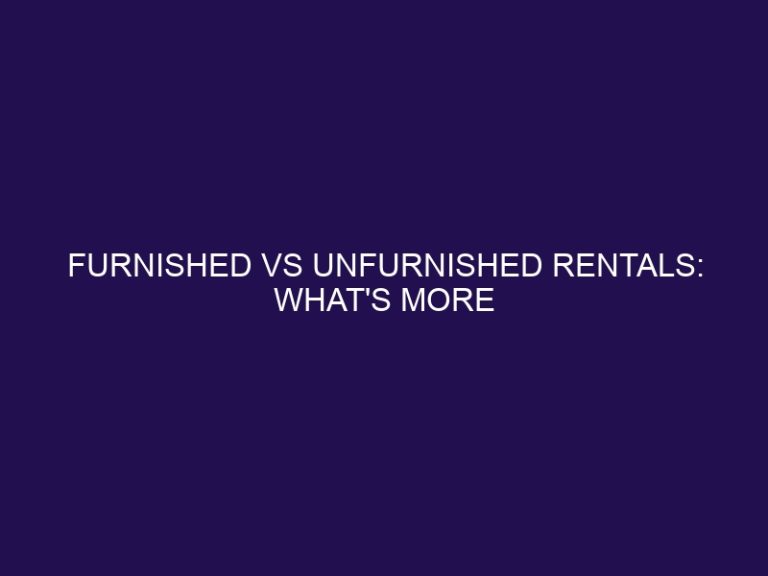Should You Use Interac e-transfer to Collect Rent?
Interac e-transfer is a popular electronic payment service offered by Interac, a Canadian payment network. It allows users to send and receive money securely and instantly using their email address or mobile phone number. With the rise of digital payment options, many landlords are considering using Interac e-transfer for rent collection. In this article, we will explore the benefits and drawbacks of using this service for rent collection.
Firstly, Interac e-transfer works by linking your bank account to your email or phone number, allowing you to send and receive money easily. The sender initiates the transfer through their online banking, and the recipient receives a notification to deposit the funds.
For rent collection, landlords can send a request for payment to their tenants, who can then transfer the rent amount directly from their bank account. This offers several benefits, including:
- Convenience for Tenants: Many people are accustomed to using Interac e-transfer for various transactions, making it a convenient option for tenants to pay their rent.
- Instant Payment: Rent payments are processed instantly, providing landlords with immediate access to funds.
- Record Keeping: Interac e-transfer provides a record of the payment, making it easier for landlords to keep track of rent payments.
However, there are fees associated with using Interac e-transfer for rent collection. These include bank fees for using the online banking service and Interac e-transfer fees, which vary depending on the bank.
There are also potential security risks to consider, such as phishing scams and unauthorized transactions. It is essential to educate tenants on how to protect themselves from these risks.
Alternatives to using Interac e-transfer for rent collection include direct deposit, online payment platforms, and traditional methods like cash or cheques. Each option has its own benefits and drawbacks.
In conclusion, using Interac e-transfer for rent collection can be a convenient and efficient option. However, landlords should consider the associated fees and potential risks and choose the best option for their specific needs.
Key Takeaways:
What is Interac e-transfer?
What is Interac e-Transfer? It is a digital payment method that enables the sending and receiving of funds through email or text. This method is widely used for various transactions, such as rent collection, due to its convenience and security.
How Does Interac e-transfer Work?
- Set up: First, log into your online banking and select Interac e-Transfer.
- Recipient: Next, add the recipient’s email or mobile number.
- Amount: Then, enter the amount and a security question if needed.
- Send: Finally, confirm the details and send the transfer.
Using Interac e-Transfer is a convenient way to send money, but it is important to ensure proper security measures are in place.
How Can Interac e-transfer Be Used for Rent Collection?
As technology continues to advance, more and more landlords are turning to digital methods for rent collection. One popular option is Interac e-transfer, a secure and convenient way to transfer funds. In this section, we will discuss the various ways in which Interac e-transfer can be used for rent collection. From the convenience it offers tenants to the benefits of instant payment and record keeping, we’ll explore the reasons why this method may be a viable option for landlords.
1. Convenience for Tenants
- Easy Access: Tenants find e-transfers to be convenient for quick, hassle-free payments.
- Immediate Transactions: Instant fund transfer enables timely rent payments.
- Transaction Records: Tenants can easily track and maintain their payment records.
Utilize e-transfers to streamline rent collection and ensure tenant satisfaction with the added convenience it provides.
2. Instant Payment
- Initiate instant e-transfer: Log in to your online banking, select the recipient, enter the amount, and choose the ‘instant’ option.
- Recipient Notification: The recipient receives an email or text notification and can deposit the funds instantly.
- Confirmation: You receive confirmation once the instant payment is complete.
3. Record Keeping
- Maintain detailed records of rent payments received via Interac e-transfer for efficient record keeping.
- Organize records by date, tenant name, and amount to easily track payments.
- Utilize digital or physical folders to store transaction confirmations for future reference and efficient record keeping.
What Are the Fees for Using Interac e-transfer for Rent Collection?
As technology continues to advance, landlords are faced with the decision of whether to use traditional methods or modern solutions for rent collection. One popular method is Interac e-transfer, but many are skeptical about the fees associated with this service. In this section, we will explore the fees involved in using Interac e-transfer for rent collection, including bank fees and Interac e-transfer fees. By understanding these costs, landlords can make an informed decision on whether this method is right for their rental business.
1. Bank Fees
- Check your bank’s fee schedule for e-transfer charges.
- Consider any flat fees or per-transaction charges related to bank fees.
- Assess if the fees align with your budget and tenant preferences when it comes to bank fees.
2. Interac e-transfer Fees
Interac e-transfer fees can vary depending on the financial institution, with most ranging from $0.50 to $1.50 per transaction for senders. Some banks may offer unlimited e-transfers for a flat monthly fee, while recipients typically do not have to pay any fees for receiving e-transfers.
What Are the Security Risks of Using Interac e-transfer for Rent Collection?
While Interac e-transfer is a convenient and popular method for collecting rent payments, it is important to be aware of the potential security risks that come with this method. In this section, we will discuss the various security risks that landlords may face when using Interac e-transfer for rent collection. From phishing scams to unauthorized transactions, we will examine the potential threats that landlords should be cautious of when utilizing this payment option.
1. Phishing Scams
- To avoid falling victim to phishing scams, refrain from clicking on links or opening attachments from unknown senders.
- Before providing any personal or financial information, always verify the authenticity of the sender.
- For added security, regularly update and use strong, unique passwords for your email and banking accounts.
- Consider enabling multi-factor authentication as an extra layer of protection.
In 2017, a widespread phishing scam targeted Interac e-transfer users, resulting in financial losses for many individuals. The scam involved fraudulent emails prompting recipients to click on a link and provide personal banking details.
2. Unauthorized Transactions
- Monitor Account: Regularly check your bank statements for any unauthorized transactions.
- Enable Alerts: Set up transaction alerts to receive notifications for any unauthorized activity.
- Secure Connection: Always use secure and trusted networks when initiating e-transfers to prevent unauthorized transactions.
What Are the Alternatives to Using Interac e-transfer for Rent Collection?
While Interac e-transfer has become a popular method for collecting rent, it may not be the best option for every landlord or tenant. In this section, we will explore the various alternatives to using Interac e-transfer for rent collection. From direct deposit to online payment platforms to traditional methods, we will discuss the pros and cons of each option and help you determine which method may be the most suitable for your specific needs.
1. Direct Deposit
- Establish direct deposit with your bank.
- Share your banking details with tenants.
- Explain the process for initiating direct deposit to tenants.
- Confirm receipt of rent payments in your bank account.
After implementing direct deposit for rent collection, landlord-tenant relationships improved due to the convenient and efficient payment process.
2. Online Payment Platforms
- Research the best online payment platforms such as PayPal, Stripe, and Square.
- Compare their transaction fees, user interface, and customer support.
- Integrate your chosen platform with your rent collection system for a seamless payment process.
3. Traditional Methods
- Cash or Check: Tenants can pay rent using traditional methods such as cash or checks.
- Bank Transfer: Landlords may also opt for bank transfers directly into their accounts.
- Money Orders: Tenants can purchase money orders to pay rent.
Before the digital age, landlords and tenants relied on traditional methods like cash, checks, and money orders for rent collection.
Is Interac e-transfer a Good Option for Collecting Rent?
As technology continues to advance, so do the methods of collecting rent. One popular option is Interac e-transfer, which allows for quick and convenient transfer of funds between parties. But is it the best choice for landlords? In this section, we will weigh the pros and cons of using Interac e-transfer as a method for collecting rent, and help you determine if it is the right choice for your rental business.
1. Pros
- Convenient: Allows tenants to transfer rent seamlessly.
- Quick: Provides instant payment confirmation.
- Records: Facilitates easy tracking of rent transactions.
My friend used Interac e-transfer to collect rent from tenants, highlighting the pros of this method. It streamlined payments, and the instant confirmation reduced delays.
2. Cons
Potential disadvantages of utilizing Interac e-transfer for rent collection include:
- Transaction fees
- Security risks such as phishing scams
- Potential inconvenience for tenants who do not have access to online banking
Frequently Asked Questions
Is Interac e-Transfer a good option for collecting rent from young tenants?
Yes, Interac e-Transfer is a great option for collecting rent from young tenants. It is fast, secure, and convenient, making it the preferred method of payment for both landlords and tenants.
How can Interac e-Transfer help with managing payments and avoiding missed payments?
Interac e-Transfer allows for real-time payments, automating the process of requesting and receiving payments. This helps landlords stay on track with their rental income and avoid the hassle of collecting money from multiple tenants.
What are the security features of Interac e-Transfer?
Interac e-Transfer uses a security question and answer system to ensure that only trusted accounts can receive the funds. It also protects against digital fraud and phishing scams, giving landlords peace of mind when collecting rental money.
Can landlords use Interac e-Transfer to request and manage payments from tenants?
Yes, landlords can use Interac e-Transfer to request and manage payments from tenants. They can also use features like Request Money and Autodeposit to simplify the process of collecting and depositing rental income.
Are there any benefits for landlords if they switch to using Interac e-Transfer for collecting rent?
Yes, there are several benefits for landlords if they switch to using Interac e-Transfer. They can save time and money by avoiding paper trails, bounced checks, and banking fees. They can also have a more detailed documentation of rental payments for their accounting process.
What should landlords do if they are new to Interac e-Transfer and want to use it for collecting rent?
If you are a new landlord and want to use Interac e-Transfer for collecting rent, you should first make sure that your bank account is set up for online banking. Then, you can create a profile with your bank to get started with using the service.







